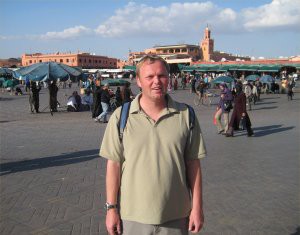 |
I’d visited Morocco previously, and spent some time sleeping out in the desert.
I wanted to see a bit more of the culture and people and since the adventure company were running a trip there, I thought why not. |
| Due to flight times, I arrived a day before everyone else, so I was able to settle in (the hotel was just across the road from the Medina).
For lunch I had a steak sandwich with chips in the hotels restaurant.
There were 2 waitresses there. One was very efficient and the other was very friendly I couldn’t decide which one I liked the most.
From my balcony, I saw this porter, having a nap in his own trolley. |
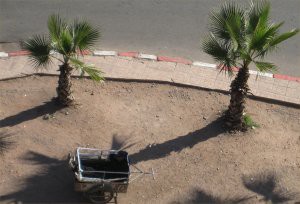 |
 |
In the afternoon I went out exploring. I decided to wander around the Medina.
I had been told to beware of people who would give directions, and then demand money as a guiding fee.
Because of this, I got lost and ended up walking around for 2 hours before I found my way out.
In the evening, I wandered around the outer wall of the Medina.
I stop along the way, to read my guidebook, and find that Bread is so valuable to the Burbers, that people say a short prayer before removing it from the road, if its been dropped. |
|
I walked into the main square.
As the guidebook said, the place literally comes alive at night.
I had seen it featured on several cookery programs, it is the only market in the world listed as a world heritage site.
I had some fresh orange juice while I was there. |
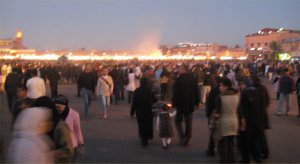 |
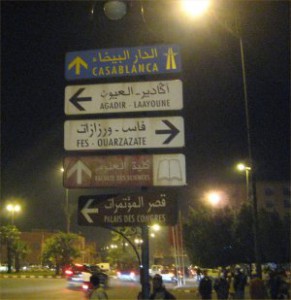 |
Casablanca is the financial capital of Morocco, and unfortunately, the film Casablanca was shot completely in Hollywood.
In the morning, the tour starts promptly at 9:30, straight after breakfast.
As usual, our guide is a consummate professional and gives us a 40 minute talk about Morocco, what things to look out for, and what things to watch out for.
Apparently, one of the new defunct Italian lera coins is the same size as a quite valuable Moroccan coin. |
| One thing I love about the adventure company trips, are there ability to find the best local experts.
Our main guide (on the left) introduces us to the chap in the centre, who gives us an extensive tour of the Medina.
Here, we stop in a Riad. Travellers would bring there wares long distances then put camels and things in the main square before settling into accommodation around the high balcony’s above.
It was impossible to properly photograph the Riad, without using a helicopter or fireman’s ladder. |
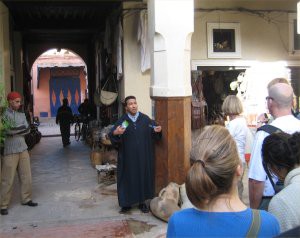 |
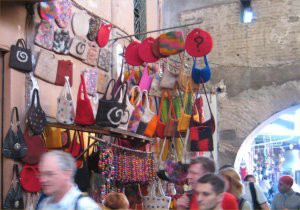 |
As well as a thriving tourist area, the Medina is actually a functioning market.
Most of the traders are grouped together and linked, so the slipper makers are quite near the leather sellers for example.
I’ve previously been taught how to sharpen knives, on a bushcraft course. It amazed me, to see several people who actually did this for a living.
Around the Medina are dye, felt, leather and metal workers.
In this picture, we pass the stall of the only remaining felt maker in the Medina. |
| We were told that most people would like to be paid, if you wanted to photograph them (seemed fair to me, as there were some fantastic photo opportunity’s).
These leather workers didn’t want any money to be photographed.
Not the best picture I’ve ever taken, but it shows some at work, watching dvd’s on a colour tv.
This is the reality I suppose. We imagine them to be poor, but they have been trading for thousands of years. Although simple people, they are probably far more enterprising than most would think. |
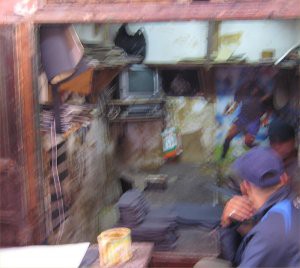 |
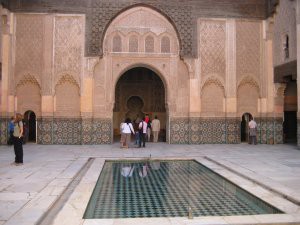 |
We visit the mosque, right in the centre of the Medina.
It was a calming and relaxing place to rest, and an oasis amidst the hustle and bustle of the Medina outside.
Our guide was explaining some of the principles of Islam.
All the things in the mosque are mathematical in origin, like arches and patterns.
There are no actual symbols like cows or water or anything like that.
The idea was that a person connection with God should be spiritual, and any pictures or carvings would become the focus, rather than the actual connection.
He also explained the 5 principles of Islam, and one surprise to me, was that a pilgrimage to Mecca costs around 35,000md. |
| The food market. This was where the locals, actually came to buy food.
We buy some things for a picnic, then hit the road.
We set off for Alt Ben Hadou, I end up sitting in the front of the bus.
At one point an “unruly” tractor nearly causes an accident, and I accidentally teach the driver some bad English words. |
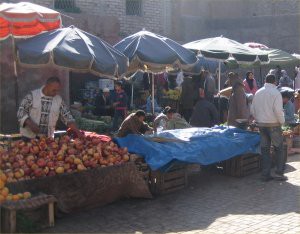 |
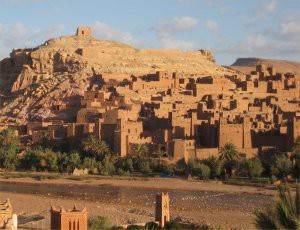 |
We stop on the way to eat our packed lunch, than drive through the mountains for several hours.
Our guide gives us a talk on the Moroccan family law, which defines ages at which people can get married and stuff like that.
We arrived at Alt Ben Hadou in the dark, so I couldn’t see much of the place.
Interestingly, the water that supplies the hotel, comes from a sea spring. I had a shower, but as it was salt water, it was impossible to get it to lather up.
We had a delicious evening meal, washed down with a few cans of beer and a glass of wine.
It was cold at night, since the area is high up in the mountains, but I had enough blankets, so I was fine.
In the morning, we eat breakfast on the terrace, with this spectacular view of the old town.
84 family’s live outside the actual village, in the place I’m standing and only 5 live physically in the village (there are rules about only cooking on wood fires and stuff like that, for those that choose to live there). |
| We cross the shallow river and I see this archway.
Our guide explains that this is a fairly recent addition. Loads of films have been made here, and this Gate was constructed for Jewel of the Nile (if you haven’t seen it, its the one where they “drive” an F16 out of the fort and shoot the doors away with missiles). |
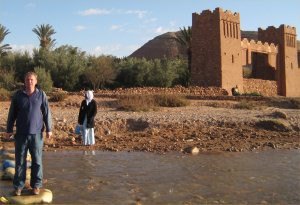 |
 |
Its fairly well know that the are was used in the film Gladiator.
Our guide holds up a picture, showing the arena that was erected just outside the Kasbah for filming. |
| The buildings are being constantly repaired and re-built and here you can see some clay bricks drying in the sun.
Bricks made from Clay and straw have been used since the beginning of time and are mentioned in the bible. |
 |
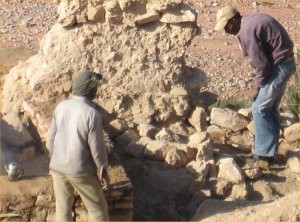 |
Some builders working to repair the fort.
I have always believed, that people in the world, aren’t that different (for example, while in London, watching loads of people walking to work, in comparison, wandering around Marrakech first thing in the morning, the expressions on the faces of the people, didn’t look that different.
On the bottom left of this photo, you can see the kettle, builders around the world, are especially alike !. |
| Inside the Kasbah, its right out of Tomb Raider. |
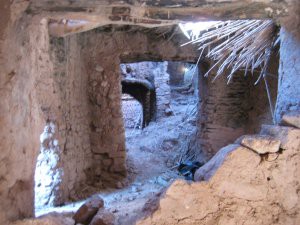 |
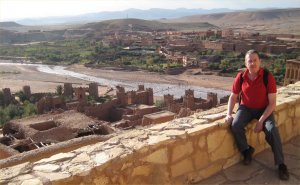 |
Tony poses overlooking the valley.
I told a few of my friends, about the trick I had learned on my travel photography course.
If you really want a picture taken right, and you want to be in it, you stand with the person you want to take the picture and guide a 3rd person to stand where your going to stand.
This results in a near perfect picture, every time. |
| It’s said that in Morocco, nothing happens without Tea.
We are invited for some tea, and to see how traditional carpets are made.
The carpet shop owners wife shows us how they are actually made (the weaving frame belonged to her grandmother).
Women wear tattoos to show if they are married, how many children they have etc. |
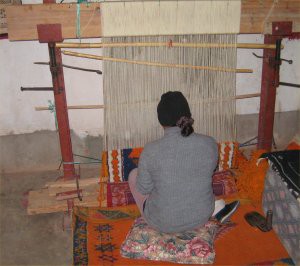 |
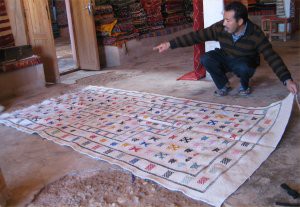 |
Wedding rugs are unique to the Burbers and not general across Morocco.
Our guide explains, that once a marriage is arranged, the bride will start to make a rug.
Symbols on the rug, will reflect how she wishes to live (whether she wants more freedom, or more protection, how many children she would like to have etc). |
| Delicious chicken for lunch, and then we hit the road, once again.
The whole while I was in Morocco, it was pretty rare to find beer and when I did it was very expensive.
I saw this garage at the side of the road, advertising cold beer, and I couldn’t believe my look.
Our driver just carried on without stopping.
As I saw the building from the other side, I noticed that all the cars were of 70’s American manufacture.
Our guide explained, that it wasn’t actually a working garage, and that it had been used as a set for the film, The hills have eyes, and was never taken down. |
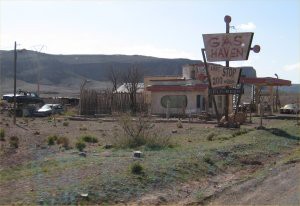 |
 |
I had read about the famous tree climbing goats.
I really couldn’t believe what I was seeing. |
| Our next stop is Tardount, sometimes called little Marrakech, as it has a wall around it.
We wander around the streets during the evening (Sagun comes back with a new handbag, which doesn’t surprise anyone).
The locals drove around on mopeds, with a gay abandon, which at times I found terrifying.
After a delicious evening meal of Beef Kofti, a few of us chat, and the remainder play cards, especially purchased for the occasion.
I was chatting to Don and he bet me his wife Sue would almost certainly win.
She was Australian, and had grown up in a place called Calagory, where they didn’t have tv, until the 80’s.In the morning we sit together in the hotel for breakfast, drink coffee and eat french bread with butter (the French really don’t know how lucky they are to eat like that every day). |
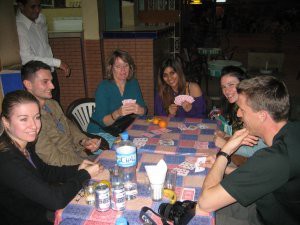 |
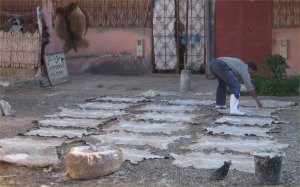 |
After the best nights sleep of the trip, we pop down for breakfast and enjoy coffee, with french bread and real butter (the French just don’t realise how lucky they are).
We then head of to a tannery, where we see how animal skins are prepared.
I had done this sort of thing on Bushcraft courses before, and found the factory atmosphere, a bit un-inspiring.
Many of the other people were practically sick. |
| In Taradount’s history, there was a rebellion, during which, the Berbers backed the wrong side.
As a result they were completely wiped out.
Today they have returned, and usually wear blue. Our guide was also wearing blue that day, but said it was of no significance, he just liked those clothes.
He explained how men would bring food with them to work and then “hire” a tajine to cook it from.
At lunchtime they would come back, the food would be cooked, and they would tuck in.
To avoid confusion, people put tomatoes, forks etc on top of their Tajine, to mark it. |
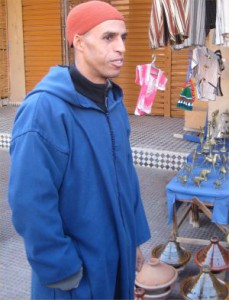 |
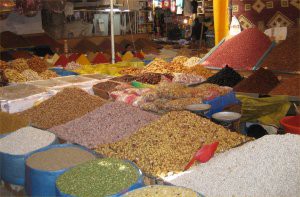 |
As we continued our tour of the market, we purchased some food for a packed lunch (we would be eating in the mountains for lunch again.
I grabbed some flat bread for emergency’s (I always had some in my day sack, in case I got hungry) and then found some “proper” French bread and cheese. Delicious.
This is one of my favourite photographs on all of my trips. The colours in the spice souk were amazing.
We split into 2 groups, and while exploring with Alistair, a guy said our friends had gone to the oil house.
They said that to everyone, the oil house seemed to be a very lucrative “attraction”. |
| That evening, we would be starting out 2 night stay in the Burber house. We set out for buy some wine for the evening.
We found a bar and had a can of flag (the local brew) while we were waiting.
The inside of the bar would have made an adequate lavatory back in the UK. |
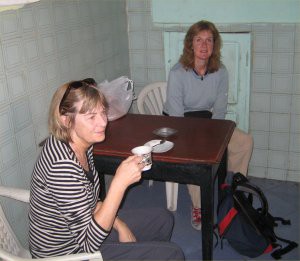 |
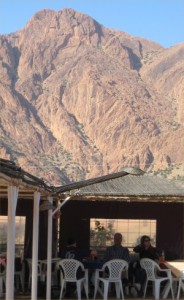 |
At this point we are met by our 3 land rovers, and head for our next destination along mountain roads.
At one point we stop and get a chance to walk along the pass.
This a picture of some of the cliffs that flanked each side of the road.
We stop for refreshments before heading to the Burber house we will share for the next 2 days.
In the background is the famous Tete Du Lion, or the lion faced mountain. |
| Back in the Landrover, feels like adventure again.
Took turns on seats in the land rover. There was plenty of room, and considering how much time we spent on the road, this was appreciated by everyone.
The track up to the Burber house was very uneven, so we had to get out of the land rovers.
It gave an opportunity to take this pretty smart picture. |
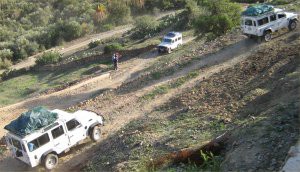 |
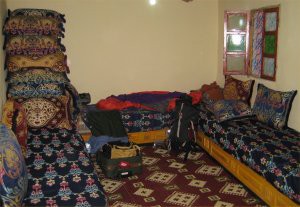 |
Initial confusion in the Burber house, as there are 3 rooms, and people are moving back and forward with bags like on a school trip.
I debate sleeping on the roof, but decide to stay indoors (in the end, I am in the minority).
In the evening, I give a brief (for me !) talk on travel equipment, which seems well received. |
| Our drivers, cooks and porters, all worked to different schedules.
As we sat down to eat our evening meal, we could hear singing comming from the kitchen.
Two of our crew were good friends who hadn’t met up in a while. One produced a violin, and the other a water container as an improvised drum.
It really was a lesson for me, to see these simple people with nothing, improvising entertainment and having a whale of a time.
Back home in my country, many youngsters without a playstation consider themselves poverty stricken, and they could learn a lesson from these 2. |
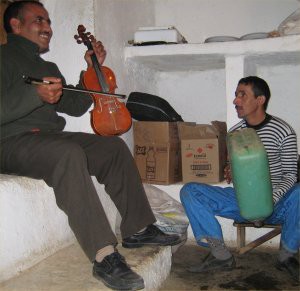 |